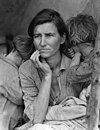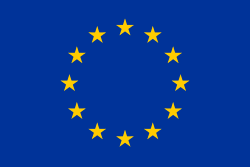Portal:Geschichte des 20. Jahrhunderts
In 1.041.879 Artikeln: Portal Geschichte des 20. Jahrhunderts Ur- und Frühgeschichte · Alter Orient · Altertum · Ägyptologie · Griechische Antike · Römisches Reich · Byzanz · Mittelalter · Heiliges Römisches Reich · Frühe Neuzeit · Britisches Weltreich · Preussen · Österreich-Ungarn · 19. Jahrhundert · Sezessionskrieg · Wilder Westen · 20. Jahrhundert · Imperialismus und Weltkriege · Sowjetunion · Nationalsozialismus · DDR … Die Ausgangslage zum kurzen 20. Jahrhundert | ||
Kurze Einleitung Das 20. Jahrhundert wird auch als das „kurze Jahrhundert“ (1914–1989) bezeichnet. Darin war der Erste Weltkrieg die „Urkatastrophe“ der 113 Kriege. Es gab 22 Friedensschlüsse, drei Kapitulationen, 11 Waffenstillstandsabkommen, fünf Abkommen zur Verhinderung von Kriegen. Einige Monarchien wurden aufgelöst und neue Staaten entstanden. Nach den Goldenen Zwanzigern hatte die Weltwirtschaftskrise eine große Arbeitslosigkeit und Armut zur Folge. Wegen der Schwäche des Völkerbundes entstanden Totalitäre Ideologien, worauf der Zweite Weltkrieg, Holocaust und große Vertreibungen folgten. Die Atombombenabwürfe hatten eine verheerende Wirkung. Die Interessengegensätze der Supermächte erzeugten den Kalten Krieg durch den sog. Eisernen Vorhang zwischen Ost- und Westeuropa. Die großen Kriegsfolgen bewirkten europäische Einigungsbewegungen und dadurch die Montanunion. Der Europarat, ein EGMR, die NATO und die EWG wurden bis zur EU verwirklicht. Erst die Montagsdemonstrationen 1989–90 konnten endgültig die Öffnungnach Osteuropa bewirken. Die Arbeits-Verdichtung der Automatisierung durch Elektronik und Computer veränderten die Arbeitswelt, sowie die schnelle Information die Massenmedien.Siehe auch:
Aktuelles Thema WeltwirtschaftskriseAls Weltwirtschaftskrise bezeichnet man den 1929 einsetzenden schweren volkswirtschaftlichen Einbruch in allen Industrienationen, der sich unter anderem in Unternehmenszusammenbrüchen, massiver Arbeitslosigkeit und Deflation äußerte. Die Gleichzeitigkeit der Krisenerscheinungen wurde gefördert durch die gewachsene Verzahnung der Einzelwirtschaften und Finanzströme (Kapitalmobilität). Die Weltwirtschaftskrise beendete die so genannten „Goldenen zwanziger Jahre“. Aufgrund der Überproduktion von Konsumgütern und landwirtschaftlichen Produkten, übertraf das Angebot die Nachfrage, was zu einem Produktionsstillstand in einigen Unternehmen führte. Eine Depression war die Folge. Viele Unternehmen meldeten Konkurs an und entließen ihre Arbeiter.Die sog. „Zwanziger Jahre“ wurden in Europa hauptsächlich über kurzfristige Kredite in Milliardenhöhe finanziert. Diese forderten die USA beim Einbruch der dortigen Volkswirtschaft zurück, da die Banken zahlungsunfähig waren. Viele Bürger hatten sich zur Zeit des Aufschwungs mit Aktien an der guten wirtschaftlichen Lage beteiligen wollen. Der Verkauf von über 16 Millionen Aktien am 24. Oktober 1929, dem Schwarzen Donnerstag, ließ den amerikanischen Aktienmarkt zusammenbrechen. Dies führte zu einer Umkehr der Finanzströme. Gelder, die in den Jahren davor in andere Volkswirtschaften investiert worden waren, wurden überstürzt abgezogen. In vielen europäischen Staaten und in anderen Staaten der Welt löste dieser Kreditabzug schwerste wirtschaftliche Krisenerscheinungen aus. In der Kette der Ereignisse kam es unter anderem zu Massenarbeitslosigkeit und einem massiven Rückgang des Welthandels durch protektionistische Maßnahmen. In den einzelnen Staaten wurde unterschiedlich auf die Herausforderung …
| Portale und Artikel Übersicht Politische Geschichte: Wirtschafts- und Sozialgeschichte: Kultur- und Geistesgeschichte: Umwelt und Energie: bearbeiten | Mitmachen Das WikiProjekt 20. Jahrhundert betreut die Artikel in diesem Themengebiet – neue Autoren sind immer herzlich willkommen. Bitte trage dich hier ein. Artikel bewerten
bearbeiten Fehlende Artikel Sachartikel: Alain de Libera - Anschlag von Reyhanlı (en) (tr) - Arabischer Kalter Krieg (en) (ar) - KPD-Aufruf 1945 - Aurepa - Bloody Friday (Glasgow) (en) - Bundesmanteltarifvertrag (BMT- Fern.) - Büssing & Sohn - Demokratischer Studentenbund zu Berlin - Deutsche Kriegsgefangene in den Vereinigten Staaten - Four Policemen (wd) - Jagdgesellschaft der NVA - Massenmorde im Sartowitzer Wald - Muhammad-al-Durrah-Vorfall (en) (es) (fr) - National Labour Organisation (en) – Operationen Dragon Rouge und Dragon Noir - Pikku-Berliini (fi) - Politik durch Pressemitteilungen (en) - Ramscherkrieg - Spätkolonialismus - Standklimaanlage - Strafverfahren gegen Adolf Loos wegen Schändung sowie Verführung zur Unzucht (1928) - Strukturfaschismus - Umsturz in Syrien 1949 (en) - Trucker-Festival - UN-Flüchtlingslager - US/Saudi AWACS Sale (en) - Wackenhut - Wiener Appell Biografien: Georg Barke - Walter Bäumer (Regisseur) - Mahfoud Ali Beiba (en) - Werner Bellmann - Fernand Bleyfuesz - Stephen Jones (Autor) (en) - Richard Eugene McCrosky - Jules Moch (en) - Emmanuel Rakotovahiny (en) - Adam Feliks Graf Ronikier (en) - Sabah as-Salim as-Sabah (en) - Hubert Schmetz (en) - Gerd-Rüdiger Stephan - mehr bearbeiten Neue Artikel • 14.07. (6233) Kimura · Alexander Georgiew (Maler) · Ann Itto Leonardo · Benita Sarah Bailey · Berndorf (Rötz) · Bettina Dziggel · Busbahnhof Tallinn · Der verschwundene Schatz · Dieter Dohmen · Emil Stutzer · Emma Lucy Braun · Erna Zarges-Dürr · FiBS Forschungsinstitut für Bildungs- und Sozialökonomie · Griseldis (Film) · Harro Pirch · Herbert Bergmann-Hannak · Hermann Rohwedder · Honjō Mutsuo · Horie Shigeo · Hōjō Hideji · Ivan Djurovic · Jessica May (Schauspielerin) · Johannes Nowara · John Douglas Hazen · Julia Cimafiejeva · Kraftwerk Pagbilao · Maria Huber · Miss Senide · Museum für die Naturgeschichte des Versteinerten Waldes von Lesbos · Negue Djogo · Pier Augusto Albrici · Porto Amazonas · Reinhardt Ferdinand Albert Has · Revolutionärer Regierungsrat · Sergei Sergejewitsch Kulagin · Shakir Ali Noori · Sugiura Norio · Tashi Choden · Tiger Willi · Wandbild „Den Gegnern und Opfern des Faschismus“ · Wilhelm Briemann · Willard Pearson · Wladimir Tortschilin • 13.07. Bettie I. Alfred · Hjemmefronten · (6230) Fram · Adrianópolis (Paraná) · Amt Heiden-Reken · Amt Velen-Ramsdorf · Andreas Höntsch · Andrew J. Boyle · Arne Drogseth · Berna Laçin · Brianna Joy Chomer · Charles Kimberlin Brain · Chicago Athenaeum · Claudia Becker · Clifford William Robinson · Ein gewisser Katulla · Einar Magnussen · Fabio Contestabile · Fukushi Kōjirō · H. H. Kung · Haager Kodifikationskonferenz · Heinrich Jenny-Fehr · Hermann Böcker (Maler) · Horst Kruse (Historiker) · Ida Maclean · Irmgard Siebert · Jakob Martin Pettersen · Josef Bigler · Kunstmuseum Fukuoka · Lola Pereira Varela · Madras and Southern Mahratta Railway · Martina Mouchot · Noboru Tanaka (Regisseur) · Paul Höller · Philip Lake · Rasmus Nordbø · Sarah Niles · The Devil’s Foot · Tunas do Paraná · Ulrich Fasshauer · Walter Reichenmiller · William Pugsley · Çağla Irmak • 12.07. Brunnen der Lebensfreude · Brüder (Hilary Mantel) · Gali Adilbekowitsch Adilbekow · The Man with the Twisted Lip · AdmiralCloud · Axlek · Biervliet · Cronenmühle · Guaratuba · Kaminfegerchen · Serodix · (6223) Dahl · (6228) Yonezawa · Alexander Miklosy · Amt Gemen-Weseke · Amt Marbeck-Raesfeld · Anabelle Stehl · Betty Ogwaro · Bruno Raetsch · Campo do Tenente · Cassidy Hutchinson · Christian Friedrich von Arnstedt · Danielle Deadwyler · Detlev von Rumohr · Diana Rubin · Diarmid Noel Paton · Edward Akrout · Elsenbach (Neumarkt-Sankt Veit) · Erwin von Auersperg · Feichten (Neumarkt-Sankt Veit) · Franz Albl · Friederike Heller · George R. Mather · Gerhard Benzig · Hans von Guretzky-Cornitz · Harald Johan Løbak · Isa Jahnke · Jon Monnard · József Szterényi · Karl Benner (Landrat) · Karl Neff (Unternehmen) · Kurzer Besuch bei Hermann Glöckner · Landung in der Jacquinotbucht · Lorenz Bahr · Luis Plattner · Marcello Foa · Marcus Anderson Jr. · Martin 146 · Martin Klaus (Pädagoge) · Nikolai Sergejewitsch Leonow · Paula Bonet · Peter Blos · Petter Jakob Bjerve · Richard Morse · Sarah Calburn · Theodor Weber (Landrat) · Wiesbach (Neumarkt-Sankt Veit) · Wilhelm Reeb · Wolfgang Lehnert bearbeiten |
Ausgewählte Biographien Persönlichkeiten--Politiker Wissenschaft--Wirtschaft--Sozial Kultur--Musik--Literatur siehe auch Portal:Biografien... bearbeiten | Geschichte in den Kontinenten Europa: Amerika: Asien: Afrika: Ozeanien: | |
Qualitätsprädikat: | ||
Auf dieser Seite verwendete Medien
Die Europaflagge besteht aus einem Kranz aus zwölf goldenen, fünfzackigen, sich nicht berührenden Sternen auf azurblauem Hintergrund.
Sie wurde 1955 vom Europarat als dessen Flagge eingeführt und erst 1986 von der Europäischen Gemeinschaft übernommen.
Die Zahl der Sterne, zwölf, ist traditionell das Symbol der Vollkommenheit, Vollständigkeit und Einheit. Nur rein zufällig stimmte sie zwischen der Adoption der Flagge durch die EG 1986 bis zur Erweiterung 1995 mit der Zahl der Mitgliedstaaten der EG überein und blieb daher auch danach unverändert.Portrait shows Florence Thompson with several of her children in a photograph known as "Migrant Mother". The Library of Congress caption reads: "Destitute pea pickers in California. Mother of seven children. Age thirty-two. Nipomo, California." In the 1930s, the FSA employed several photographers to document the effects of the Great Depression on the population of America. Many of the photographs can also be seen as propaganda images to support the U.S. government's policy distributing support to the worst affected, poorer areas of the country. Lange's image of a supposed migrant pea picker, Florence Owens Thompson, and her family has become an icon of resilience in the face of adversity. However, it is not universally accepted that Florence Thompson was a migrant pea picker. In the book Photographing Farmworkers in California (Stanford University Press, 2004), author Richard Steven Street asserts that some scholars believe Lange's description of the print was "either vague or demonstrably inaccurate" and that Thompson was not a farmworker, but a Dust Bowl migrant. Nevertheless, if she was a "Dust Bowl migrant", she would have left a farm as most potential Dust Bowl migrants typically did and then began her life as such. Thus any potential inaccuracy is virtually irrelevant. The child to the viewer's right was Thompson's daughter, Katherine (later Katherine McIntosh), 4 years old (Leonard, Tom, "Woman whose plight defined Great Depression warns tragedy will happen again ", article, The Daily Telegraph, December 4, 2008) Lange took this photograph with a Graflex camera on large format (4"x5") negative film.[1]
Yalta summit in February 1945 with (from left to right) Winston Churchill, Franklin Roosevelt and Joseph Stalin. Also present are USSR Foreign Minister Vyacheslav Molotov (far right); Field Marshal Alan Brooke, Admiral of the Fleet Sir Andrew Cunningham, RN, Marshal of the RAF Sir Charles Portal, (standing behind Churchill); George Marshall, Army Chief of Staff and Fleet Admiral William D. Leahy, USN, (standing behind Roosevelt).
Peace dove
(c) Lear 21 in der Wikipedia auf Englisch, CC BY-SA 3.0
The Fall of the Berlin Wall, 1989. The photo shows a part of a public photo documentation wall at the Brandenburg Gate, Berlin. The photo documentation is permanently placed in the public.
Autor/Urheber: User:Kolossos, Lizenz: CC BY-SA 3.0
Schöner Brunnen in Nürnberg
Autor/Urheber: Der ursprünglich hochladende Benutzer war Ulrich.fuchs in der Wikipedia auf Deutsch, Wikipedia Logo: Wikimedia Foundation, Lizenz: CC BY-SA 3.0
Banner Qualitätsoffensive














